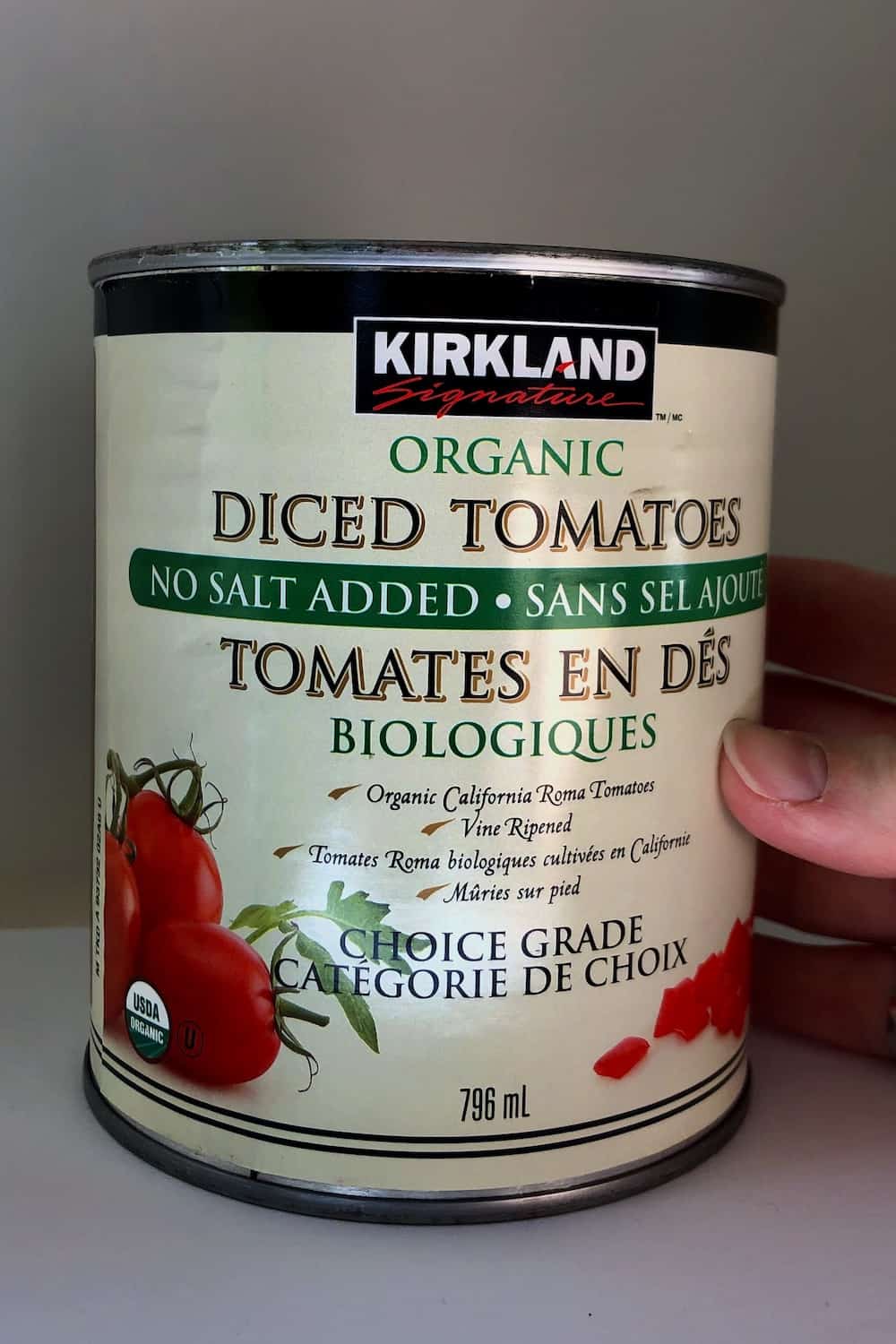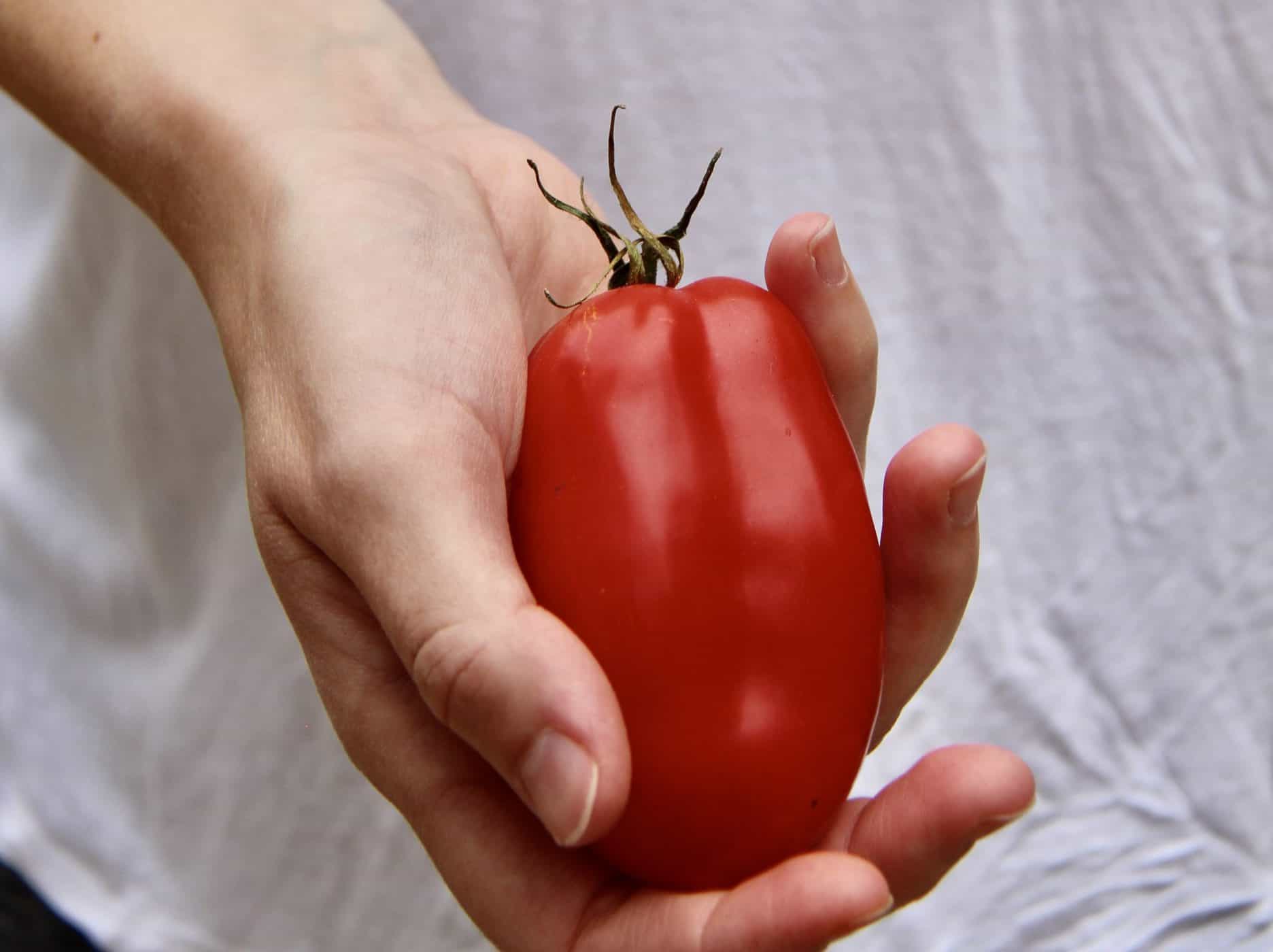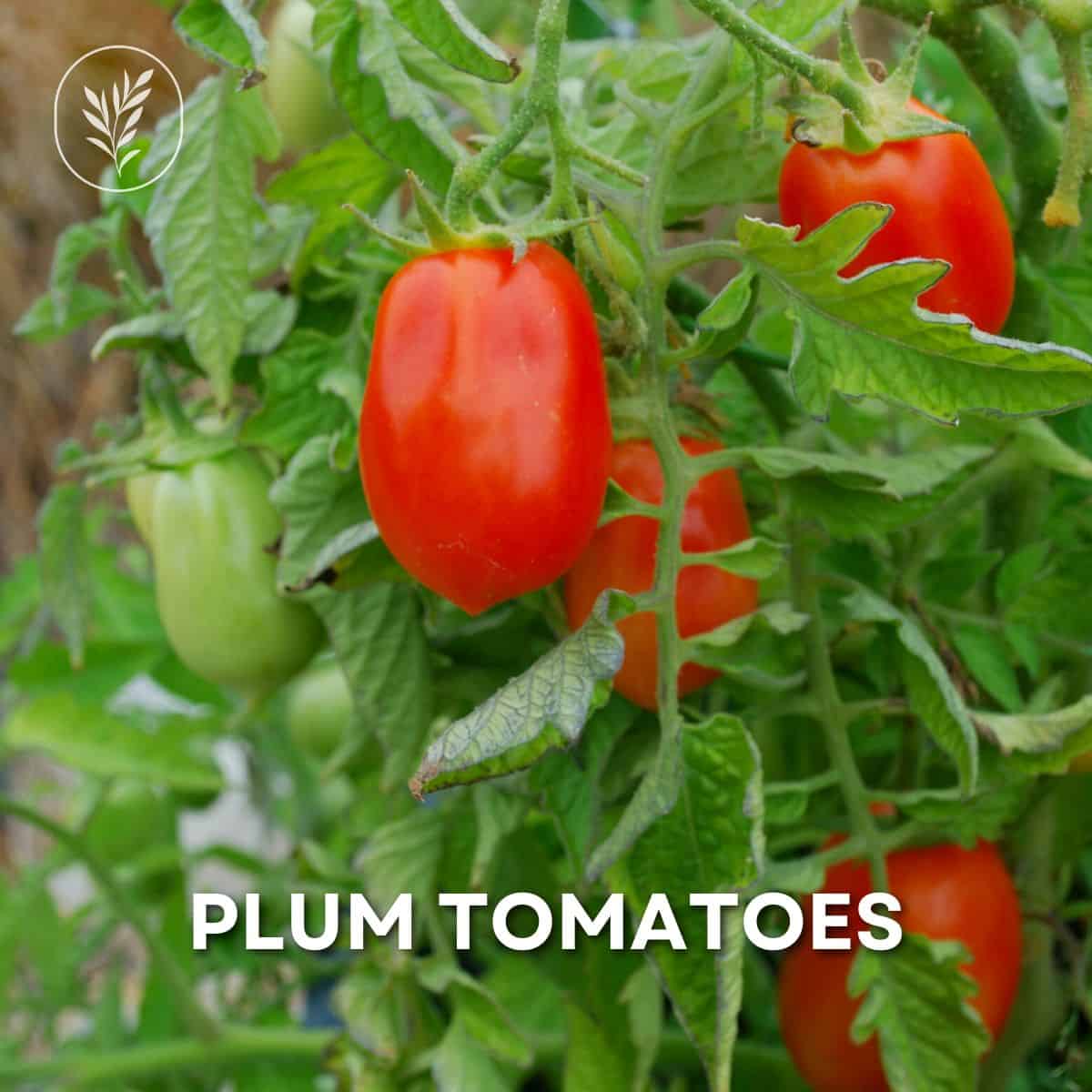Plum tomatoes are dense, oblong tomatoes most commonly used to make tomato sauce. The most popular varieties are Roma, San Marzano, Amish Paste, and Big Mama. Plum tomatoes are also known as processing tomatoes, sauce tomatoes, paste tomatoes, pear tomatoes, Italian cooking tomatoes, or Pomodoro Perini.
Plum tomato basics
Plum tomatoes are long, plum-shaped, dense tomatoes grown specifically for making tomato sauce. Plum tomato plants have been bred over hundreds of years to produce the best tomatoes for making tomato sauce. They tend to have excellent flavor and a thick, dense texture and are good ingredients for tomato juice, sauce, soups, and stews. Plum tomatoes are often roasted with olive oil, sea salt, and/or garlic.
Plum tomatoes generally have an oval plum-like shape, and sometimes are pear-shaped or egg-shaped. This oblong shape allows for only 2 seed compartments, called locules, inside the plum tomato. Fewer seed compartments translate to more yummy tomato pulp! It also means less work while cleaning out the seed pockets as part of tomato processing. Dense tomatoes that are mainly pulp with few seeds are referred to as “meaty”.
Plum tomatoes have also been bred for market handling and packing and generally have a long shelf life in good conditions. Most plum tomatoes are red in color. Look for brightly-colored skin and gently feel the tomato for plumpness. Plum tomatoes are more firm when ripe than most other types of tomatoes.
Plum tomatoes are one of the five main types of tomatoes.

Varieties of plum tomatoes
Here are some popular varieties of plum tomatoes:
- Roma
- San Marzano
- Ropreco Paste
- Amish Paste
- Big Mama

Here are some harder-to-find plum tomato cultivar types:
- Supremo
- Speckled Roman
- Rio Grande
- Black Plum
- Gladiator
- Lucky Tiger
- Banana Legs
- SuperSauce
- Orange Icicle
- Black Icicle
- Chocolate Pear
- Jersey Devil
- Howard’s German
- Striped Roman
- Martino’s Roma
- Opalka
- Rocky
- San Remo
- Juliet Tomato
It’s usually fairly easy to buy Roma and San Marzano plum tomatoes at the grocery store. For the more specialty types, you may have better luck at the farmer’s market, or even growing your own tomatoes!

Italian plum tomatoes
Italian varieties of plum tomatoes are certainly the most well-known types and also the most widely available. They’ve been bred specifically for making classic flavorful Italian tomato sauce! Roma and San Marzano are the most popular two varieties of Italian plum tomatoes:
Italian plum tomatoes are also known as paste tomatoes, pear tomatoes, or pomodoro perini. They can also be referred to as Italian cooking tomatoes.
Plum tomatoes vs. Roma Tomatoes
The Roma Tomato is a specific variety of plum tomato. This variety was developed by the USDA in the 1950s. Roma tomatoes are grown from Roma VF tomato seeds. Roma plants are determinate (bush tomatoes) and generally easy to grow.
Roma VF tomatoes are perhaps the most common commercially grown variety of plum tomatoes. This variety is perfect for making Italian-style tomato sauce and tomato paste.
Plum tomatoes vs. San Marzano tomatoes
San Marzano tomatoes are a popular Italian heirloom variety of plum tomatoes. Some gardeners refer to San Marzano tomatoes as their “fancy Romas”. San Marzano tomato seeds are easy to find due to the popularity of this variety. San Marzano plants are indeterminate (long-vining tomatoes).
San Marzano tomatoes have pointed ends when compared to the more rounded Romas.

Canned plum tomatoes
Plum tomatoes are as commonly sold canned as they are sold fresh. Most canned plum tomatoes are Italian varieties of plum tomatoes, such as Roma or San Marzano. Some canned tomatoes are imported from Italy, while other brands are grown domestically.
An important note about canned plum tomatoes is that canned plum tomatoes are rarely labeled as “plum tomatoes.” The term “plum tomatoes” is used in English-speaking countries, while most canned plum tomatoes are imported from Italy. When buying canned plum tomatoes, look specifically for the words Roma or San Marzano, or look for a photo or drawing of oblong tomatoes (as opposed to round tomatoes). They may also be labeled “whole peeled plum tomatoes.”

Fresh plum tomatoes
Fresh plum tomatoes can be sliced up and eaten fresh, added to cooking, or processed into tomato sauce. They also taste wonderful straight out of the garden.
Fresh plum tomatoes should be kept at room temperature rather than in the fridge, as the fridge can dull their flavor and give them a bit of a mealy texture. Let them ripen on the vine if possible. If your tomatoes are already off the vine and you know you won’t use them in the next few days, slice them up and roast them in the oven with some olive oil, sea salt, and/or garlic (see recipes at the bottom of this page).
Growing plum tomatoes
Plum tomato-type plants are generally easy to grow. They are among the smaller types of tomatoes and therefore don’t take months and months to grow on the vine. They’re also generally resistant to the typical pests and diseases of tomato plants. Plum tomatoes can be grown in containers/pots or directly in the garden soil in the ground.
The easiest way to grow plum tomatoes is by buying plum tomato seedlings from a nursery or garden center. More experienced gardeners may wish to grow their plants from seeds by starting the seeds indoors in early spring. Keep tomato plants indoors in the spring until daily temperatures are consistently above 50°F (10°C), as the growth of the roots ceases in cold temperatures.
Tomato plants grow especially well in raised garden beds. Remove the bottom leaves off the stem and plant the seedling quite deep (about 6″-8″ below the soil line of the seedling). You can also use a slow-release organic fertilizer like Dr. Earth Tomato Fertilizer or Espoma Garden-Tone Organic Fertilizer.

Buying plum tomatoes by the pound
Plum tomatoes are sold in bulk by the pound. Generally, they’re in a large bin and labeled at a price per pound. The price of fresh plum tomatoes in our area is about $3/pound ($6.50/kg).
Look for brightly-colored fruits that are not so firm they’re hard but not so soft they’re mushy. In terms of size, most ripe plum tomatoes are 2-3 inches long, although some specialty varieties vary widely.
How many plum tomatoes are in a pound? There are about 5 or 6 fresh plum tomatoes in one pound. For canned plum tomatoes, the smaller 15 oz cans (450 ml) are equal to about one pound of fresh tomatoes, and the larger 28 oz cans (825 ml) are more like 2 pounds of plum tomatoes.
Grape tomatoes (mini plum tomatoes)
Grape tomatoes are small plum tomatoes. Grape tomatoes are small like cherry tomatoes, but also oblong like plum tomatoes. They’re sweet, mini plum-shaped tomatoes that are perfect for fresh snacking and on salads – especially when locally-grown cherry tomatoes are not in season.
Here are some varieties of grape tomatoes (small plum tomatoes):
- Tiger Stripes
- Datterino
- Italian Winter Grape
- Little Mama
- Yellow Pear
- Brad’s Atomic Grape

Recipes with plum tomatoes
There are tons of fantastic recipes with plum tomatoes! These flavorful tomatoes are wonderful in pasta dishes, hearty soups and stews (like chili), and casseroles. You can use them in most recipes that call for tomatoes. Here are some wonderful recipes to try:
- Simple Roasted Plum Tomatoes
- Garlicky Pasta with Fresh Tomatoes and Basil
- Slow-Roasted Plum Tomatoes With Garlic and Oregano
- String Beans with Plum Tomatoes
- Slow-Roasted Tomatoes with Sea Salt & Ground Coriander
- Spaghetti with Fresh Tomato & Basil Sauce
If you don’t have plum tomatoes, any firm tomato will make a good substitute. Watery or mealy fresh tomatoes make poor substitutes for plum tomatoes in recipes that call specifically for plum tomatoes in the ingredients.










